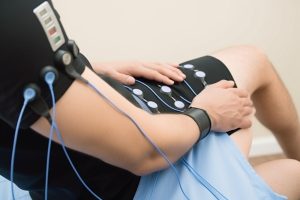The Power of Electrical Muscle Stimulation (EMS): A Comprehensive Guide
In the world of fitness and wellness, Electrical Muscle Stimulation (EMS) is emerging as a revolutionary technique. Also known as Neuromuscular Electrical Stimulation (NMES) or electromyostimulation, EMS involves the use of electric impulses to elicit muscle contractions. In this article Magic body and Soul explores the multifaceted world of EMS, delving into its various applications and shedding light on its efficacy in diverse scenarios.
Unlocking the Potential of Electrical Muscle Stimulation (EMS)
EMS has gained significant traction in recent years, and for good reason. It serves as a versatile tool, finding applications in several domains, including strength training, rehabilitation, and even muscle function evaluation. This is largely due to its unique ability to activate muscles promptly, making it a preferred choice for many. Let’s explore its applications in greater detail.
Leveraging EMS for Strength Training
Magic body and Soul know Athletes and fitness enthusiasts are increasingly turning to EMS as a valuable addition to their training routines. The electric impulses generated by EMS devices, delivered through electrodes placed on the skin near targeted muscles, closely mimic the natural action potential from the central nervous system. This, in turn, triggers muscle contractions, aiding in muscle development and strength enhancement. Recent studies have underlined the effectiveness of EMS in pre-exercise muscle activation, making it a valuable tool for optimizing workouts.
www.magicbodyandsoul.com +16475098524 EMS Vaughan
Rehabilitation and Prevention with EMS
One of the most significant advantages of EMS is its role in rehabilitation and prevention. For individuals who are partially or entirely immobilized, such as those recovering from injuries, EMS offers a lifeline. It helps combat muscle atrophy, a common concern in such cases. By stimulating muscle contractions, EMS ensures that muscles remain engaged and active, even when traditional forms of exercise are not feasible. This not only aids in recovery but also prevents muscle imbalances. It’s essential to differentiate EMS from Transcutaneous Electrical Nerve Stimulation (TENS), as the desired outcomes differ. While TENS is primarily used for pain relief, EMS focuses on muscle development, targeting all major muscle groups to foster strength and endurance adaptations.
Aiding Progressive Diseases with EMS
Patients battling progressive diseases like cancer or chronic obstructive pulmonary disease can also benefit from EMS. In cases where traditional exercise may not be possible or safe, EMS offers a ray of hope. Research indicates that EMS can improve muscle weakness in these individuals, leading to statistically significant gains in quadriceps muscle strength and potentially increased muscle mass. Although further research is needed to strengthen these claims, EMS shows promise in helping individuals spend fewer days confined to their beds, thereby improving their quality of life.
www.magicbodyandsoul.com +16475098524 EMS Vaughan
EMS for Weight Loss: Debunking Myths
While EMS has garnered attention for various applications, it’s crucial to dispel some misconceptions. The FDA does not certify EMS devices for weight reduction. EMS-induced calorie burning is marginal at best, and significant calorie expenditure occurs when the entire body engages in physical exercise, including muscles, the heart, and the respiratory system. However, some argue that EMS can indirectly lead to weight loss. By toning muscles through electrical stimulation, individuals may feel more inclined to participate in physical activities, as their bodies become better prepared for exercise.

Unpacking the Effects of EMS
Research indicates that EMS, when used for strength training, complements the effects of traditional resistance training. It triggers neural and muscular adaptations that enhance overall performance. However, the effectiveness of EMS can vary based on specific factors and protocols. Different types of EMS may activate various muscle fibers, each with unique responses. Some programs focus on fatigue resistance, while others prioritize force production, catering to specific training goals.
A Historical Perspective on EMS
The roots of EMS trace back to the 18th century when Luigi Galvani provided scientific evidence that electrical currents can activate muscles. Throughout the 19th and 20th centuries, researchers meticulously studied the electrical properties responsible for muscle movement. It was during this time that they discovered the long-term changes that electrical stimulation induced in muscles, marking a significant milestone in understanding EMS. In the 1960s, Soviet sport scientists harnessed the power of EMS, claiming remarkable force gains in elite athletes. However, the conflicting results of these studies were due to a lack of comprehensive understanding of how EMS truly operates. Over time, medical physiology research clarified the mechanisms behind EMS, highlighting its ability to induce adaptation in muscle fibers, blood vessels, and nerves.
Regulatory Framework in the United States
In the United States, EMS devices are subject to stringent regulation by the U.S. Food and Drug Administration (FDA). The FDA classifies EMS devices into two categories: over-the-counter (OTC) and prescription devices. OTC devices are designed for muscle toning, while prescription devices require medical supervision and are intended for therapeutic purposes. The FDA mandates that device manuals prominently display contraindicications, warnings, precautions, and potential adverse reactions. These regulations ensure the safe and appropriate use of EMS devices in the United States, protecting consumers from potential risks.
www.magicbodyandsoul.com +16475098524 EMS Vaughan
Notable EMS Devices
Several EMS devices have made their mark in the consumer market, targeting home-based users. These devices often come in the form of wearable units, such as ab toning belts. While some have gained popularity, it’s essential to note that not all EMS devices meet FDA standards. It’s crucial for consumers to verify the certification of these devices before use.
In Conclusion
As Magic body and Soul research, Electrical Muscle Stimulation (EMS) is a dynamic and versatile tool with applications ranging from strength training and rehabilitation to muscle function evaluation. While it’s not a magic solution for weight loss, it plays a pivotal role in enhancing muscle development and performance. Understanding the regulatory framework in the United States and choosing certified devices is crucial for a safe and effective EMS experience. As the field of EMS continues to evolve, it offers new possibilities for individuals seeking to maximize their physical potential. call +16475098524 to get free consult.




